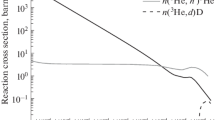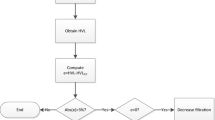Abstract
The linear attenuation coefficients and buildup factor of MCP-96 alloy were determined for 60Co, 54Mn, and 137Cs gamma emitters and a NaI detector. The thickness of the MCP-96 attenuator was varied from 1 to 4 cm. A collimated beam of gamma rays was allowed to pass through various thicknesses of the MCP-96 alloy. The attenuated beam was detected by a NaI detector, and data were recorded by a multichannel analyzer. The run was repeated without the collimator for broad-beam geometry. For each run, the attenuated beam intensity was normalized by the intensity of the unattenuated incident beam obtained by removing the attenuators. Linear attenuation coefficients were determined by plotting of the intensity of the collimated beam against the attenuator thickness. For every thickness of the alloy, the ratio of the attenuated to the unattenuated beam was found to be higher in broad-beam geometry as compared to the same ratio in narrow-beam geometry. We used the difference in these ratios in broad and narrow-beam geometries to calculate the buildup factor. The buildup factor was found to increase with beam energy and attenuator thickness. Variation in the source-to-detector distance gave a lower value of the buildup factor for a small and a large distance and a higher value for an intermediate distance. The buildup factor was found to be greater than 1 in all cases. We conclude that the buildup factor must be calculated and incorporated for dose correction and precision when the MCP-96 alloy is used for tissue compensation or radiation shielding and protection purposes.







Similar content being viewed by others
References
Kerur B, Manjula V, Lagare M, Kumar S. Mass attenuation coefficient of saccharides for X-rays in the energy range from 8 keV to 32 keV. Radiat Meas. 2009;44:63–7.
Maqbool M. Determination of transfer functions of MCP-200 alloy using 6 MV photon beam for beam intensity modulation. J Mech Med Biol. 2004;4:305–10.
Ding GX, Duggan DM, Lu B, Hallahan DE, Cmelak A, Malcolm A, Coffey CW. The need for accurate dose calculation algorithms with inhomogeneity corrections in treatment planning for a small lung tumor treatment. Int J Radiat Oncol Biol Phys. 2007;69:S697–8.
Foster EB, Wilson J, Badkul RK, Kimler BF, Smith M, Reddy EK, Wang F. The influence of heterogeneity dose correction and beam energy on planned field margins for thoracic tumors. I J Radiat Oncol Biol Phys. 2009;75:S622–3.
Maqbool M, Ahmad I. Spectroscopy of gadolinium ion and disadvantages of gadolinium impurity in tissue compensators used in radiation treatment planning. Spectroscopy. 2007;21:205–10.
Anscher MS, Thrasher B, Rabbani Z, Teicher B, Vujaskovic Z. Antitransforming growth factor-β antibody 1D11 ameliorates normal tissue damage caused by high-dose radiation. Int J Radiat Oncol Biol Phys. 2006;65:876–81.
Yaes RJ. Late normal tissue injury from permanent interstitial implants. Int J Radiat Oncol Biol Phys. 2001;49:1163–9.
Dische S, Saunders MI, Williams C, Hopkins A, Aird E. Precision in reporting the dose given in a course of radiotherapy. Radiother Oncol. 1993;29:287–93.
Mosbacher MR, Wuu CS, Kutcher GJ, Isaacson SR. Int J Radiat Oncol Biol Phys. 2002;54:322–32.
Fogliata A, Vanetti E, Albers D, Brink C, Clivio A, Knöös T, Nicolini G, Cozzi L. On the dosimetric behaviour of photon dose calculation algorithms in the presence of simple geometric heterogeneities: comparison with Monte Carlo calculations. Phys Med Biol. 2007;52:1363–85.
Ronald Zhu X, Prado K, Liu HH, Guerrero TM, Jeter M, Liao Z, Rice D, Forster K, Stevens CW. Intensity-modulated radiation therapy for mesothelioma: impact of multileaf collimator leaf width and pencil beam size on planning quality and delivery efficiency. Int J Radiat Oncol Biol Phys. 2005;62:1525–34.
Kutcher GJ, Burman C, Mohan R. Compensation in three-dimentional non-coplanar treatment planning. Int J Radiat Oncol Biol Phys. 1991;20:127–34.
Maqbool M, Ahmad I. Ultraviolet spectroscopy of praseodymium doped in AlN and the use of gallium nitride, as ultraviolet filters in radiation shielding and protection. Curr Appl Phys. 2009;9:234–7.
Khan FM. The physics of radiation therapy. 2nd ed. USA: Lippincott Williams & Wilkins Publishers; 1994.
Turner JE. Atoms, radiation and radiation protection. 2nd ed. New York: Wiley; 1995.
Cember H. Introduction to health physics. 3rd ed. New York: McGraw Hilll Company; 1996.
Partridge M, Donovan E, Fenton N, Reise S, Blane S. Clinical implementation of a computer controlled milling machine for compensating filter production. Br J Radiol. 1999;72:1099–103.
Mejaddem Y, Lax I, Adakkai SK. Procedure for accurate fabrication of tissue compensators with high density material. Phys Med Biol. 1997;42:415–21.
Mageras GS, Mohan R, Burman C, Barest GD, Kutcher GJ. Compensators for three dimensional treatment planning. Med Phys. 1991;19:133–40.
Yang F, Hamilton JH. Modern atomic and nuclear physics, International. USA: McGrawhill Companies Inc.,; 1996.
Littlefield TA. Atomic and nuclear physics—an introduction. USA: Littlefield Press; 2008.
Khan FM, Gibbons JP, Roback DM. Collimator (head) scatter at extended distances in linear accelerator-generated photon beams. Int J Radiat Oncol Biol Phys. 1996;35:605–8.
Hendee WR, Ibbott GS, Hendee EG. Radiation therapy physics. 3rd ed. USA: Wiley; 2005.
Sauer QA. Calculation of dose distributions in the vicinity of high-Z interface for photon beams. Med Phys. 1995;22:1685–90.
Mujaddem Y, Hyödynmaa S, Brahme A. Photon scatter in intensity modulating filters evaluated by first Compton scatter and Monte Carlo calculations and experiments in broad beams. Phys Med Biol. 2000;45:2747–60.
Acknowledgment
We are thankful to the Indiana Academy of Science for providing financial support for our experimental work through the Senior Research Grants Program.
Author information
Authors and Affiliations
Corresponding author
About this article
Cite this article
Hopkins, D.N., Maqbool, M. & Islam, M.S. Linear attenuation coefficient and buildup factor of MCP-96 alloy for dose accuracy, beam collimation, and radiation protection. Radiol Phys Technol 5, 229–236 (2012). https://doi.org/10.1007/s12194-012-0158-1
Received:
Revised:
Accepted:
Published:
Issue Date:
DOI: https://doi.org/10.1007/s12194-012-0158-1




